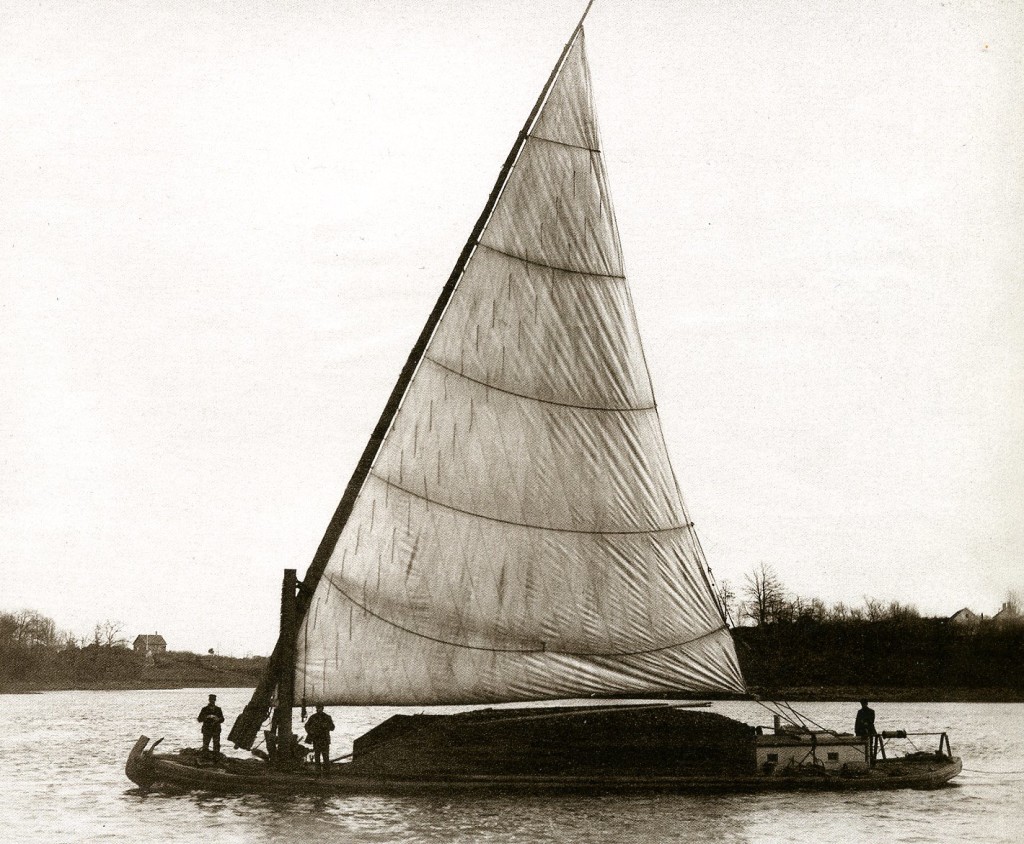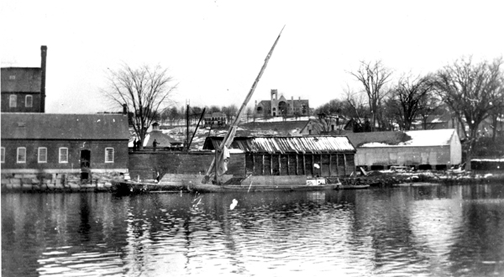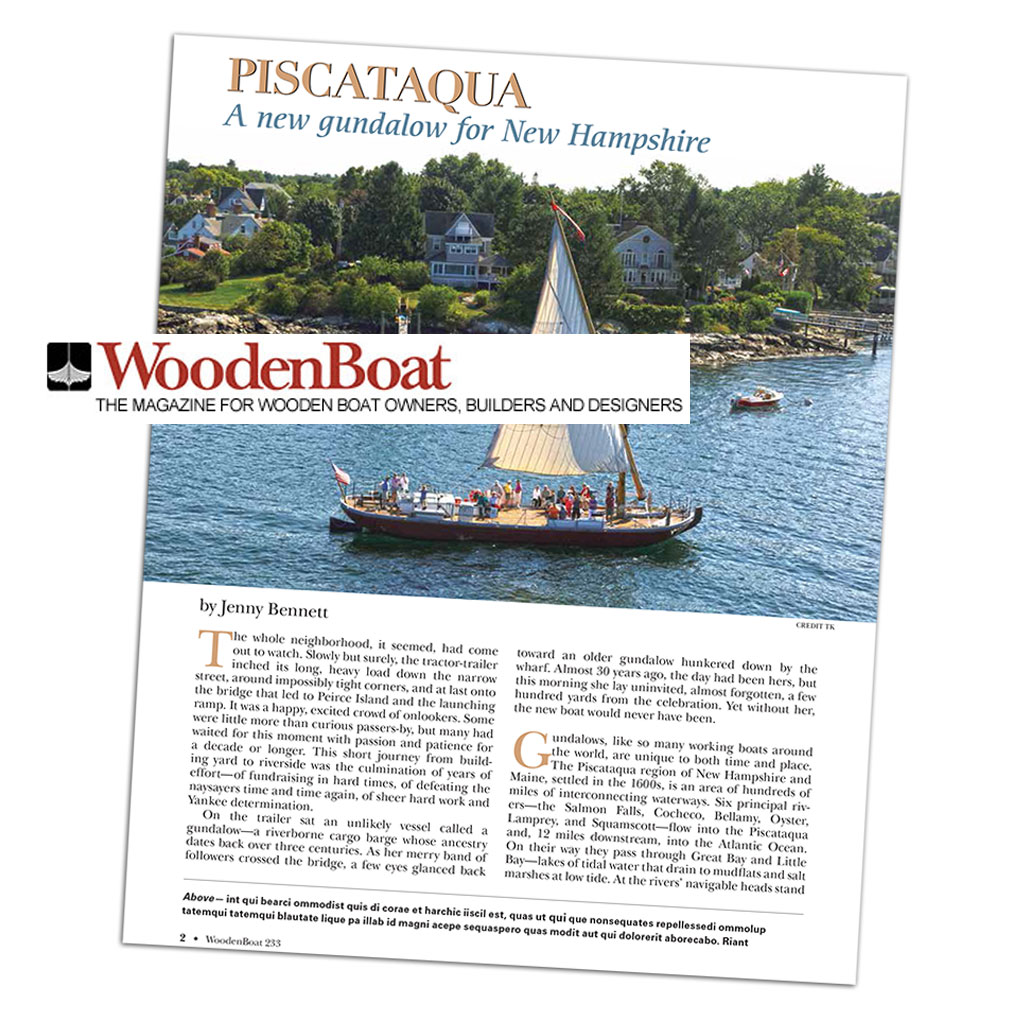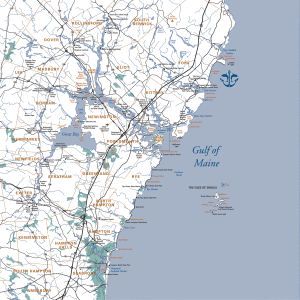What is a gundalow?
A gundalow is a shallow drafted type of cargo barge, once common in the Gulf of Maine’s rivers and estuaries. The Piscataqua gundalow began as a simple undecked barge, first appearing in the mid 1600s, poled or rowed with long sweeps (oars). From the 1700s into the 1900s gundalows evolved into fully decked flat-bottomed cargo carriers with a cabin and lateen sail that could be lowered to “shoot” under bridges. The sail acted as an ‘auxiliary engine’ since gundalows depended on the tides to take them upriver on the rising tide and downriver on the falling tide.
Built from wood lot timber, most salt-water farmers, fishermen or traders simply built their own. No two gundalows were alike. The Fanny M., (photo left) launched from Adam’s Point in Durham, NH in 1886 by Captain Edward H. Adams, was the last gundalow to operate commercially in the area. Drawings of the Fanny M. in the collection of the Smithsonian Institution inspired the design of the new gundalow Piscataqua.
Gundalows were the equivalent of today’s tractor-trailer rigs, sometimes measuring over 70 feet long and 19 feet wide. They could navigate shallow rivers, carrying freight of up to 50 tons between ocean-going schooners and the growing towns of the Piscataqua region. Raw cotton, spices and other goods from around the world were transported from the schooners to area businesses and factories. Farm produce, oysters and fish, lumber, manufactured goods, locally made bricks, native-hewn granite, cordwood and coal were all carried on gundalows.
Wooden Boat Magazine tells the story of the new Piscataqua.
“The whole neighborhood, it seemed, had come out to watch. Slowly but surely, the tractor-trailer inched its long, heavy load down the narrow street, around impossibly tight corners, and at last onto the bridge that led to Peirce Island and the launching ramp. It was a happy, excited crowd of onlookers. Some were little more than curious passers-by, but many had waited for this moment with passion and patience for a decade or longer.
Read full article here →The Piscataqua Maritime Region
New Hampshire has the shortest coastline of any US coastal state. Yet just east of Rye’s Odiorne Point lies the mouth of the Piscataqua River. Here the ocean tide comes flooding in twice each day, driving salty currents upstream, through Little Bay and into Great Bay. Upriver the seawater is gradually diluted by the fresh waters of seven rivers, which drain 930 square miles of watershed – 25% of the shorelands of the estuary are in Maine, 75% in New Hampshire.
This brackish mix creates the Great Bay Estuary ecosystem, with habitats such as underwater eel grass beds, intertidal rocky shores, tidal marshes and mud flats. Reaching 15 miles inland to Great Bay, this arm of the sea is one of the most recessed estuaries in the country, adding 152 miles of additional tidal shoreline in New Hampshire and 52 miles in Maine.
Rivers and Bays in the Piscataqua Region
Dover, NH – Bellamy River & Cochecho River
Durham, NH – Oyster River
Eliot, ME – Spinney Creek & Piscataqua River
Exeter, NH – Squamscott River
Greenland, NH – Winnicut River & Great Bay
Kittery, ME – Spruce & Chauncey Creeks, Piscataqua River
New Castle, NH – Little Harbor, Piscataqua River
Newfields, NH – Squamscott River
Newington, NH – Little Bay
Newmarket, NH – Lamprey River
Portsmouth, NH – Piscataqua River
Rye, NH – Rye Harbor, Little Harbor, Sagamore Creek, Witch Creek, & Seavey Creek
South Berwick, ME – Great Works River & Salmon Falls River
Stratham, NH – Great Bay
York, ME – York River & Brave Boat Harbor







